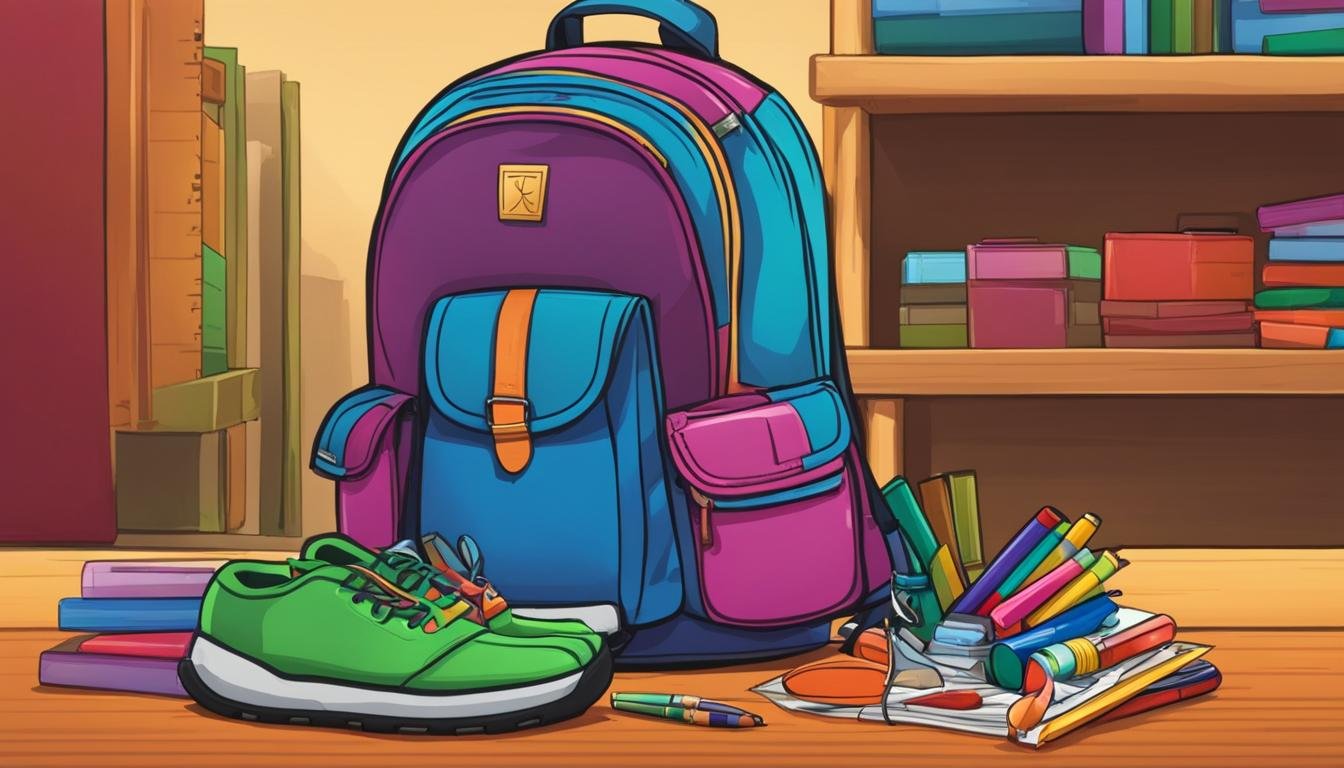Choosing the right size backpack for your child’s kindergarten year is crucial for their comfort, health, and organization. As your little one embarks on this new adventure, it’s important to ensure that their backpack is suitable for their needs. In this guide, we will provide you with all the information you need to select the perfect backpack size for your kindergartener.
Key Takeaways:
- Choosing the right size backpack is essential for your child’s comfort and well-being in kindergarten.
- A small backpack measuring 12-14 inches in height is generally suitable for kindergarten-age children.
- Consider adjustable straps and padded shoulder straps to ensure a comfortable fit.
- Look for backpacks with multiple compartments to keep your child organized.
- Choosing a backpack that is durable and functional is important for long-term use.
Importance of Backpack Size for Kindergarten Children
Choosing the right size backpack for your kindergarten child is crucial for their comfort and well-being. Research suggests that a backpack measuring 12-14 inches in height is generally recommended for this age group. It is important to consider your child’s size and weight when selecting a backpack, as one that is too big or too small can cause discomfort, back pain, and even injuries.
By opting for a backpack that is appropriately sized, you can ensure that your child can carry their belongings comfortably without straining their muscles. This will also prevent the backpack from hanging too low and potentially causing them to lean forward or backward. Remember, a properly fitted backpack will support your child’s posture and help distribute the weight evenly across their shoulders and back.
In addition to the physical benefits, a well-fitted backpack can also contribute to your child’s organization and productivity. It allows them to easily access their belongings, making it easier for them to find what they need throughout the school day. This can help foster independence and reduce stress, allowing your child to focus on their studies and enjoy their time at kindergarten.
Choosing the Right Size Backpack for Your Kindergartener
When selecting a backpack, consider your child’s needs and preferences. Look for adjustable straps that can be customized to your child’s body size, ensuring a comfortable and secure fit. Additionally, multiple compartments can help your child stay organized and easily locate their belongings. Features such as padded shoulder straps and a chest strap or waist belt can also contribute to their comfort and overall well-being.
Remember, finding the best size backpack for your kindergartener is about more than just aesthetics. Prioritize functionality, durability, and design to ensure that the backpack can withstand daily use and provide the necessary support for your child’s growing body. By choosing a backpack that is appropriately sized and well-designed, you can set your child up for success and help them thrive during their kindergarten years.
Adjustable Straps: A Key Feature for Kindergarten Backpacks
When it comes to choosing a backpack for your kindergartener, one key feature to look for is adjustable straps. Adjustable straps are essential as they allow you to customize the fit according to your child’s body size. This ensures that the backpack sits comfortably on their back, preventing any discomfort or strain on their muscles.
An ill-fitting backpack with fixed straps can often lead to discomfort and may cause your child to lean forward or backward while carrying it. This can result in poor posture and potential back pain. By opting for a backpack with adjustable straps, you can ensure that the weight is evenly distributed across your child’s shoulders, reducing the risk of any strain or discomfort.
Experts recommend selecting a backpack with padded and adjustable shoulder straps, as well as a chest strap or waist belt. These additional features further help distribute the weight evenly, providing extra support and stability for your child’s back. Adjustable straps also allow your child to wear the backpack at the right height, ensuring it does not slide down or put unnecessary pressure on their shoulders.
Finding the Right Size Backpack for Kindergarten
When it comes to selecting a backpack for your kindergartener, finding the right size is crucial. A backpack that is too big or too small can cause discomfort and even potential health issues. To ensure your child’s comfort and convenience, look for backpacks with multiple compartments.

Benefits of Multiple Compartments in Kindergarten Backpacks
Having multiple compartments in a kindergarten backpack offers several advantages. It helps children stay organized and easily access their belongings throughout the day. Look for a backpack that has a large main compartment for books and larger items, as well as smaller compartments for pencils, snacks, and other smaller essentials. Including side pockets for a water bottle is also beneficial for easy access and hydration.
By providing separate compartments, a backpack can help your child develop organizational skills from a young age. They can learn the importance of keeping items in designated places and avoid the frustration of searching for things in a cluttered backpack. Additionally, having specific compartments for different items can prevent damage or spills, ensuring your child’s belongings stay protected.
When choosing a backpack with multiple compartments, consider the size and durability of the zippers or closures. Ensure they are easy for your kindergartener to open and close independently. This will promote your child’s independence and self-reliance as they navigate their daily school routine.
Considerations for Choosing the Right Kindergarten Backpack
When selecting a backpack for your kindergartener, it is important to take into account various factors that contribute to its functionality, durability, and design. While aesthetics may be tempting, it is crucial to prioritize a backpack that is specifically designed for school use and meets your child’s needs. Here are some key considerations to keep in mind:
Functionality:
Look for a backpack with features that enhance its practicality. Opt for separate compartments to keep items organized, making it easier for your child to find what they need throughout the day. Consider backpacks with an extra compartment for a rain jacket or a built-in rain cover to protect your child’s belongings during wet weather.
Durability:
Ensure that the backpack you choose can withstand the wear and tear of daily use. Look for durable materials and reinforced stitching to ensure longevity. It is also worth considering a backpack that is machine washable for easy cleaning when needed.
Design:
Although functionality is key, finding a design that your child loves can also boost their excitement for school. Look for backpacks with clear side panels for identification purposes, allowing your child’s name and contact information to be easily visible. By prioritizing both functionality and design, you can find a backpack that not only meets your child’s needs but also reflects their personal style.
By considering these factors and carefully selecting a kindergarten backpack, you can ensure that your child has a comfortable, functional, and durable companion throughout their kindergarten journey.
Impact of Inappropriate Backpack Size on Children’s Spines
Choosing the right size backpack for your child is not just a matter of convenience and comfort; it also has a significant impact on their spinal health. Carrying a backpack that is too heavy or incorrectly sized can lead to a range of musculoskeletal issues, including back pain and spinal distortion.
When a backpack is too heavy or improperly fitted, it places excessive strain on the muscles of the back, shoulders, and neck. This strain can lead to muscle imbalances, rounded shoulders, and poor posture. Over time, the repeated stress on the spine can cause the natural curves to become distorted, potentially leading to long-term spinal issues.
To mitigate these risks, it is essential to ensure that your child’s backpack is appropriately sized and distributed. A properly fitting backpack should sit comfortably on the back, with the weight evenly distributed across both shoulders. Encouraging your child to wear both straps and adjusting them to fit snugly can help minimize the strain on their back.
Proper backpack ergonomics:
- Choose a backpack that is proportional to your child’s size, with a maximum height of 12-14 inches for kindergarten-age children.
- Look for backpacks with adjustable and padded shoulder straps, as well as a chest strap or waist belt to help distribute the weight more evenly.
- Instruct your child to wear the backpack high on their back, with the bottom of the backpack resting in the curve of their lower back.
- Ensure that the weight of the backpack is kept to a minimum by regularly checking and removing unnecessary items.

By prioritizing the correct size and fit of your child’s backpack, you can help protect their spinal health and prevent potential issues in the future. Remember, a well-fitted backpack should provide support and comfort, allowing your child to carry their belongings without compromising their well-being.
Conclusion – Ensuring a Comfortable and Functional Kindergarten Backpack
Choosing the right backpack for your child’s kindergarten year is of utmost importance to ensure their comfort, organization, and overall well-being. Based on expert recommendations and factual data, we have provided a comprehensive guide to help you select the best size backpack for your kindergartener.
For kindergarten-age children, a backpack measuring 12-14 inches in height is generally recommended. This size allows for optimal weight distribution and prevents discomfort, back pain, and potential injuries. Remember to consider your child’s size and weight when choosing a backpack, and opt for adjustable straps to customize the fit and prevent strain on their muscles.
In addition to size, pay attention to functionality. Look for backpacks with multiple compartments to help your child stay organized and easily access their belongings. A backpack with padded shoulder straps and additional features like a chest strap or waist belt can further enhance comfort and weight distribution.
Lastly, prioritize durability and design elements. Choose a backpack that is specifically designed for school use, with features like separate compartments for a rain jacket, clear side panels for identification, and machine washability for easy cleaning.
By following these guidelines and considering the comfort, functionality, size, and durability of the backpack, you can ensure that your child’s kindergarten journey is supported by a comfortable and functional backpack.
FAQ
What size backpack is suitable for kindergarten-age children?
Generally, a small backpack that measures 12-14 inches in height is suitable for kindergarten-age children.
Why are adjustable straps important for kindergarten backpacks?
Adjustable straps allow you to customize the fit according to your child’s body size, ensuring the backpack sits comfortably on their back and prevents sliding.
What are the benefits of multiple compartments in kindergarten backpacks?
Multiple compartments help children stay organized and easily locate their belongings, making it ideal for a small backpack used for kindergarten.
What factors should I consider when choosing a kindergarten backpack?
When choosing a kindergarten backpack, consider functionality, durability, and design. Prioritize features like separate compartments, clear side panels, and machine washability.
How does inappropriate backpack size affect children’s spines?
Carrying a backpack that is too heavy or incorrectly sized can cause muscle strain, distort the natural curves of the spine, and put pressure on the intervertebral discs, leading to back pain and other issues.
How can I ensure a comfortable and functional kindergarten backpack?
Choose a small backpack that measures 12-14 inches in height with adjustable straps, padded shoulder straps, and multiple compartments. Following these guidelines will ensure comfort and functionality.

